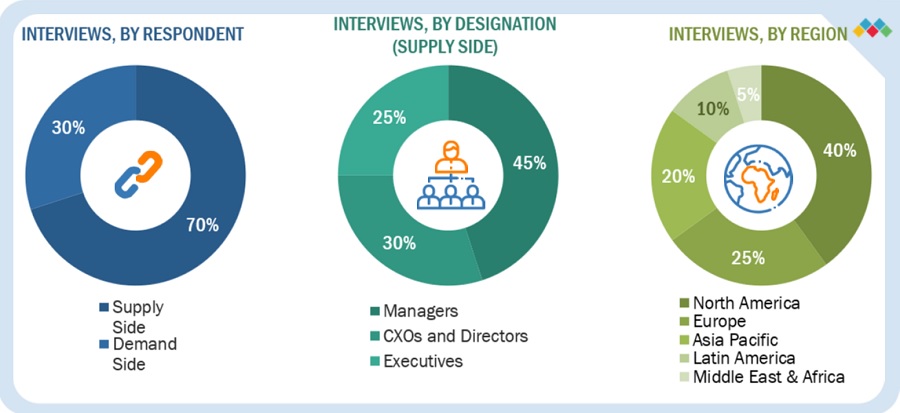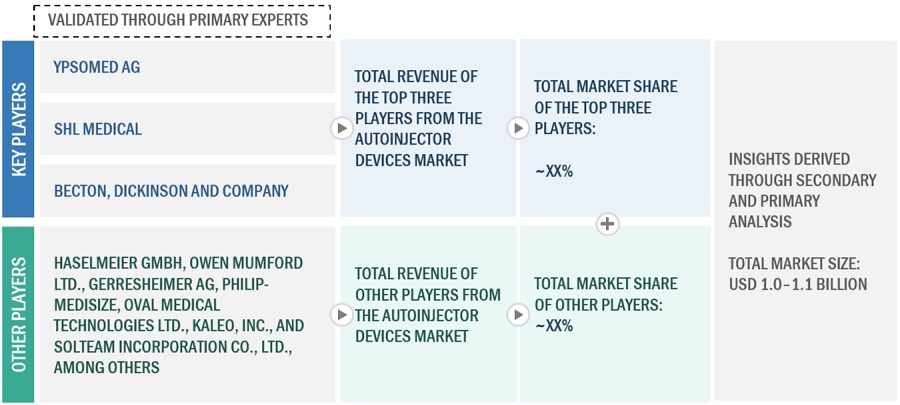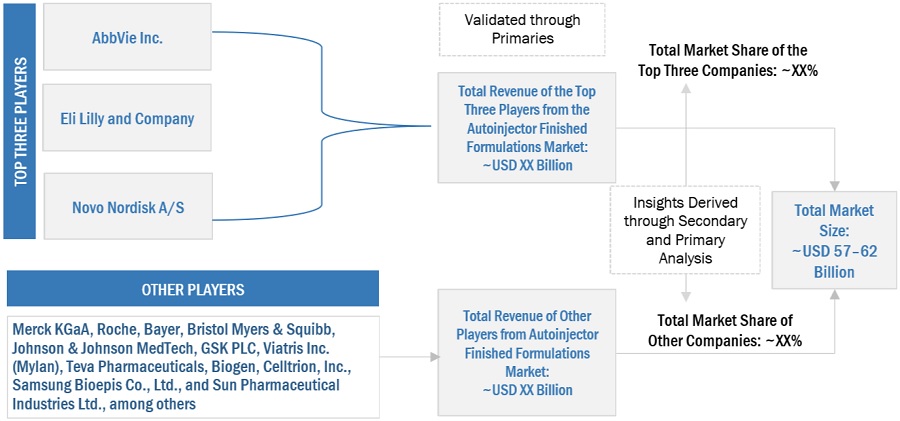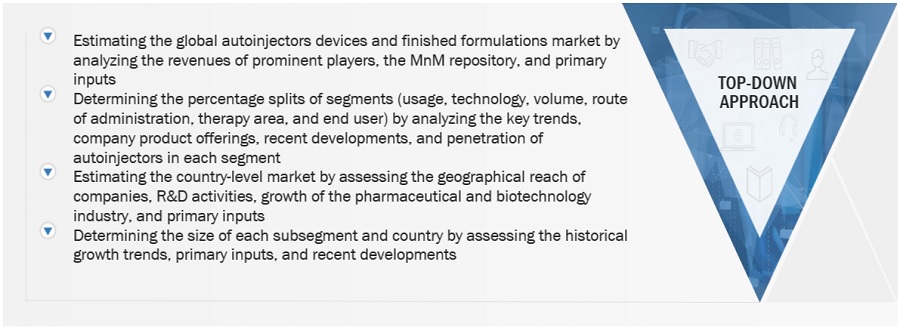The research study involved the wide use of secondary sources, directories, and databases to identify and collect valuable information for the analysis of the global autoinjectors devices and autoinjectors finished formulations market. Extensive interviews were conducted with various primary participants, including key industry members, subject-matter experts (SMEs), C-level managers of leading market players, and industry consultants, to obtain and verify qualitative and quantitative information and evaluate the growth scenarios of the market. The global market size estimated through secondary research followed by data triangulation with inputs from industry experts to arrive at the final market size.
Secondary Research
Secondary research was used mainly to identify and collect information for the technical, market-oriented, and commercial study of the autoinjectors devices and autoinjectors finished formulations market. The secondary sources used for this study include World Health Organization (WHO), National Institutes of Health (NIH), World Bank, United States Food and Drug Administration (US FDA), National Center for Biotechnology Information (NCBI), BioPharm International, EvaluatePharma, Eurostat, and Factiva, research journals; corporate filings such as annual reports, SEC filings, investor presentations, and financial statements; press releases; trade, business, professional associations and among others. These secondary sources were also used to obtain major information about key market players, and market segmentation corresponding to industry trends, regional/country-level markets, market developments, and technology prospects. Secondary data was collected and analysed to arrive at the market size of the global autoinjectors devices market and autoinjectors finished formulations market, which was further validated through primary research.
Primary Research
Extensive primary research was conducted after acquiring basic knowledge about the global autoinjectors market scenario through secondary research. Several primary interviews were conducted with market experts from the demand side, such as pharmaceutical and biotechnology companies, hospitals & clinics, patients, and ambulatory care centers, and experts from the supply side, such as C-level and D-level executives, product managers, marketing & sales managers of key manufacturers, distributors, and channel partners. These interviews were conducted across five major regions, including the Asia Pacific, North America, Europe, Latin America, and Middle East & Africa. Approximately 70% and 30% of the primary interviews were conducted with supply-side and demand-side participants, respectively. This primary data was collected through questionnaires, e-mails, online surveys, personal interviews, and telephonic interviews.
The following is a breakdown of the primary respondents:

To know about the assumptions considered for the study, download the pdf brochure
Market Size Estimation
Both top-down and bottom-up approaches were used to estimate and validate the total size of the autoinjectors market. These methods were also used extensively to estimate the size of various subsegments in the market. The research methodology used to estimate the market size includes the following:
Bottom-up Approach
-
The key players in the industry and market have been identified through extensive secondary research
-
The revenues generated from the autoinjectors business of leading players have been determined through primary and secondary research
-
All percentage shares, splits, and breakdowns have been determined using secondary sources and verified through primary sources

To know about the assumptions considered for the study, Request for Free Sample Report

Top-down Approach
After arriving at the overall market size from the market size estimation process, the total market was split into several segments and subsegments.

Data Triangulation
After arriving at the market size from the market size estimation process explained above, the total market was divided into several segments and subsegments. To complete the overall market engineering process and arrive at the exact statistics for all segments and subsegments, data triangulation and market breakdown procedures were employed, wherever applicable. The data was triangulated by studying various factors and trends from both the demand and supply sides.
Market Definition
Autoinjector devices are medical instruments engineered to administer a specific dosage of medication via either subcutaneous or intramuscular routes. These devices are employed for the delivery of various medications, including epinephrine and biologics. The components of an autoinjector device include a concealed needle, a pre-filled syringe or cartridge, a spring mechanism for automated injection, and an activation button. They are equipped with safety features, a robust outer casing, and frequently include a viewing window, facilitating the administration of medication in emergency situations in a manner that is both user-friendly and precise.
Stakeholders
-
Companies manufacturing autoinjectors
-
Original equipment manufacturing companies
-
Suppliers and distributors of autoinjectors
-
Healthcare service providers
-
Health insurance payers
-
Government bodies/municipal corporations
-
Regulatory bodies
-
Medical research institutes
-
Business research and consulting service providers
-
Venture capitalists
-
Market research and consulting firms
Report Objectives
-
To define, describe, analyze, and forecast the autoinjectors market by usage, technology, therapy area, volume, route of administration, end user, and region
-
To provide detailed information regarding the major factors influencing market growth (such as drivers, restraints, opportunities, and challenges)
-
To strategically analyze micromarkets1 with respect to individual growth trends, prospects, and contributions to the overall autoinjectors market
-
To analyze opportunities in the market for stakeholders and provide details of the competitive landscape for market leaders
-
To forecast the size of the market segments with respect to five main regions: North America, Europe, the Asia Pacific, Latin America, and Middle East & Africa
-
To profile the key players in the autoinjectors market and comprehensively analyze their product portfolios, market positions, and core competencies
-
To track and analyze competitive developments in the autoinjectors market, such as acquisitions, product launches, expansions, agreements, partnerships, and collaborations
-
To benchmark players within the autoinjectors market using the ‘Company Evaluation Matrix' framework, which analyzes market players based on various parameters within the broad categories of business strategy and product strategy
1 Micro markets are the further segments and subsegments of the autoinjectors market included in the report
Available Customizations
With the given market data, MarketsandMarkets offers customizations as per the company’s specific needs. The following customization options are available for this report:
Portfolio Assessment
-
Product Matrix, which gives a detailed comparison of the product portfolios of the top three companies.
Company Information
-
Detailed analysis and profiling of additional market players (up to three).
Geographical Analysis
-
A further breakdown of the Rest of Asia Pacific autoinjectors market into countries
-
A further breakdown of the Rest of European autoinjectors market into countries
-
A further breakdown of the Rest of Latin American autoinjectors market into countries
-
A further breakdown of the Rest of Middle East & Africa autoinjectors market into countries



Growth opportunities and latent adjacency in Autoinjectors Market